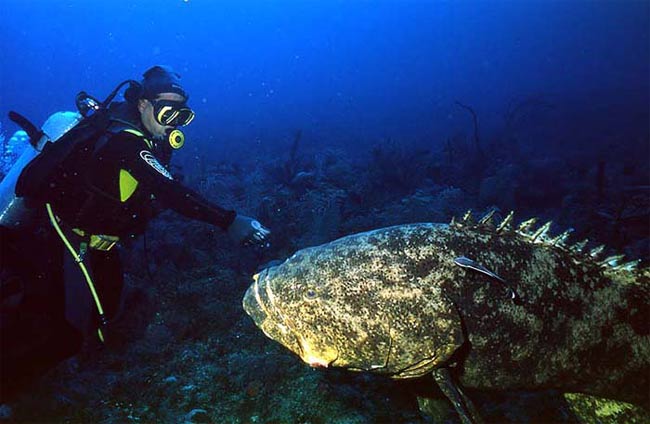Whopping Fish Declared New Species

A man-sized grouper that trolls the tropical waters of the Eastern Pacific Ocean for octopuses and crabs has been identified as a new fish species after genetic tests.
Called the goliath grouper, the fish can grow to six feet (1.8 meters) in length and weigh a whopping 1,000 pounds (454 kg). Until now, scientists had grouped this species with an identical looking fish (also called the goliath grouper, or Epinephelus itajara) living in the Atlantic Ocean.
"For more than a century, ichthyologists have thought that Pacific and Atlantic goliath grouper were the same species," said lead researcher Matthew Craig of the Hawaii Institute of Marine Biology, "and the argument was settled before the widespread use of genetic techniques."
Once upon a time, about 3.5 million years ago — before the Caribbean and the Pacific were separated by present-day Panama — they were, in fact, the same species. Now, DNA tests have revealed the two populations have distinct genes, indicating they likely evolved into two separate species after their ocean homes were divided by Central America.
Scientists disagree about how to define the term "species" and what separates species from one another biologically, though some say that a species is a group that can mate with one another and produce offspring that are not sterile. However, this biological definition doesn't always hold up, for instance, with coyotes and wolves (considered separate species), which can successfully produce fertile offspring. In this study, the scientists relied on differences in the fishes' genetic codes to establish the separate grouper species.
The new Pacific species, now designated as Epinephelus quinquefasciatus, is described in a recent issue of the journal Endangered Species Research.
The Atlantic variety, E. itajara, is currently listed as critically endangered by the IUCN, or International Union for Conservation of Nature. Due to its scarcity, E. quinquefasciatus also may be considered critically endangered.
Sign up for the Live Science daily newsletter now
Get the world’s most fascinating discoveries delivered straight to your inbox.
"In light of our new findings, the Pacific goliath grouper should be treated with separate management and conservation strategies," said researcher Rachel Graham of the Wildlife Conservation Society in New York.
The research was funded by Programa Petrobras Ambiental, Conservation International Brazil to Projeto Meros do Brasil, The Summit Foundation, National Science Foundation and Hawaii Institute of Marine Biology.
- Video: Surprising Fish Tale
- Top 10 Species Success Stories
- Image Gallery: Freaky Fish
Jeanna Bryner is managing editor of Scientific American. Previously she was editor in chief of Live Science and, prior to that, an editor at Scholastic's Science World magazine. Bryner has an English degree from Salisbury University, a master's degree in biogeochemistry and environmental sciences from the University of Maryland and a graduate science journalism degree from New York University. She has worked as a biologist in Florida, where she monitored wetlands and did field surveys for endangered species, including the gorgeous Florida Scrub Jay. She also received an ocean sciences journalism fellowship from the Woods Hole Oceanographic Institution. She is a firm believer that science is for everyone and that just about everything can be viewed through the lens of science.









